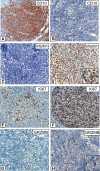Follicular lymphomas with and without translocation t(14;18) differ in gene expression profiles and genetic alterations
- PMID: 19471018
- PMCID: PMC2716022
- DOI: 10.1182/blood-2009-01-198580
Follicular lymphomas with and without translocation t(14;18) differ in gene expression profiles and genetic alterations
Abstract
Follicular lymphoma (FL) is genetically characterized by the presence of the t(14;18)(q32;q21) chromosomal translocation in approximately 90% of cases. In contrast to FL carrying the t(14;18), their t(14;18)-negative counterparts are less well studied about their immunohistochemical, genetic, molecular, and clinical features. Within a previously published series of 184 FLs grades 1 to 3A with available gene expression data, we identified 17 FLs lacking the t(14;18). Comparative genomic hybridization and high-resolution single nucleotide polymorphism (SNP) array profiling showed that gains/amplifications of the BCL2 gene locus in 18q were restricted to the t(14;18)-positive FL subgroup. A comparison of gene expression profiles showed an enrichment of germinal center B cell-associated signatures in t(14;18)-positive FL, whereas activated B cell-like, NFkappaB, proliferation, and bystander cell signatures were enriched in t(14;18)-negative FL. These findings were confirmed by immunohistochemistry in an independent validation series of 84 FLs, in which 32% of t(14;18)-negative FLs showed weak or absent CD10 expression and 91% an increased Ki67 proliferation rate. Although overall survival did not differ between FL with and without t(14;18), our findings suggest distinct molecular features of t(14;18)-negative FL.
Figures





Similar articles
-
Similar clinical features in follicular lymphomas with and without breaks in the BCL2 locus.Leukemia. 2016 Apr;30(4):854-60. doi: 10.1038/leu.2015.330. Epub 2015 Dec 1. Leukemia. 2016. PMID: 26621338
-
MicroRNA profiles of t(14;18)-negative follicular lymphoma support a late germinal center B-cell phenotype.Blood. 2011 Nov 17;118(20):5550-8. doi: 10.1182/blood-2011-06-361972. Epub 2011 Sep 29. Blood. 2011. PMID: 21960592 Free PMC article.
-
Evaluation of interphase fluorescence in situ hybridization for the t(14;18)(q32;q21) translocation in the diagnosis of follicular lymphoma on fine-needle aspirates: a comparison with flow cytometry immunophenotyping.Cancer. 2003 Dec 25;99(6):385-93. doi: 10.1002/cncr.11787. Cancer. 2003. PMID: 14681948 Clinical Trial.
-
Molecular and clinical progress in follicular lymphoma lacking the t(14;18) translocation (Review).Int J Oncol. 2020 Jan;56(1):7-17. doi: 10.3892/ijo.2019.4917. Epub 2019 Nov 21. Int J Oncol. 2020. PMID: 31789408 Review.
-
Pathology, pathogenesis and molecular genetics of follicular NHL.Best Pract Res Clin Haematol. 2011 Jun;24(2):95-109. doi: 10.1016/j.beha.2011.02.003. Epub 2011 Apr 7. Best Pract Res Clin Haematol. 2011. PMID: 21658611 Review.
Cited by
-
The prognostic value of hydroxybutyrate dehydrogenase in diffuse large B cell lymphoma.iScience. 2024 Sep 10;27(10):110905. doi: 10.1016/j.isci.2024.110905. eCollection 2024 Oct 18. iScience. 2024. PMID: 39386763 Free PMC article.
-
LAIR1, an ITIM-Containing Receptor Involved in Immune Disorders and in Hematological Neoplasms.Int J Mol Sci. 2022 Dec 17;23(24):16136. doi: 10.3390/ijms232416136. Int J Mol Sci. 2022. PMID: 36555775 Free PMC article. Review.
-
Molecular Cytogenetic Profiling Reveals Similarities and Differences Between Localized Nodal and Systemic Follicular Lymphomas.Hemasphere. 2022 Aug 10;6(9):e767. doi: 10.1097/HS9.0000000000000767. eCollection 2022 Sep. Hemasphere. 2022. PMID: 35974958 Free PMC article.
-
Increasing genomic and epigenomic complexity in the clonal evolution from in situ to manifest t(14;18)-positive follicular lymphoma.Leukemia. 2014 May;28(5):1103-12. doi: 10.1038/leu.2013.307. Epub 2013 Oct 23. Leukemia. 2014. PMID: 24153014
-
Similar clinical features in follicular lymphomas with and without breaks in the BCL2 locus.Leukemia. 2016 Apr;30(4):854-60. doi: 10.1038/leu.2015.330. Epub 2015 Dec 1. Leukemia. 2016. PMID: 26621338
References
-
- Hiddemann W, Buske C, Dreyling M, et al. Treatment strategies in follicular lymphomas: current status and future perspectives. J Clin Oncol. 2005;23:6394–6399. - PubMed
-
- Swerdlow SH, Campo E, Harris NL, et al., editors. WHO classification of tumors of haematopoietic and lymphoid tissues. Lyon, France: IARC; 2008.
-
- de Jong D. Molecular pathogenesis of follicular lymphoma: a cross talk of genetic and immunologic factors. J Clin Oncol. 2005;23:6358–6363. - PubMed
-
- Ott G, Katzenberger T, Lohr A, et al. Cytomorphologic, immunohistochemical, and cytogenetic profiles of follicular lymphoma: 2 types of follicular lymphoma grade 3. Blood. 2002;99:3806–3812. - PubMed
-
- Glas AM, Kersten MJ, Delahaye LJ, et al. Gene expression profiling in follicular lymphoma to assess clinical aggressiveness and to guide the choice of treatment. Blood. 2005;105:301–307. - PubMed
Publication types
MeSH terms
Substances
Grants and funding
LinkOut - more resources
Full Text Sources
Molecular Biology Databases
Research Materials

